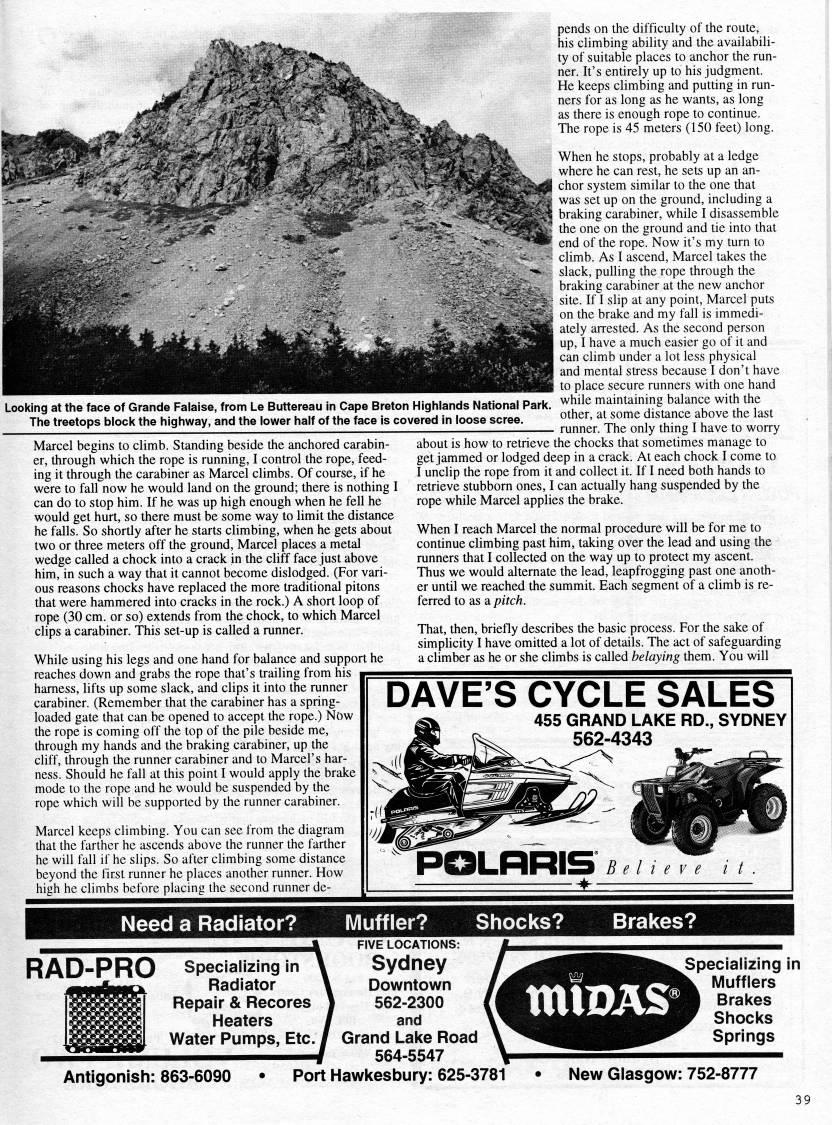Page 39 - "So How Do You Get The Rope Up"? Rock Climbing in Northern Cape Breton
Published by Ronald Caplan on 1996/12/1 (263 reads)
 Page 38 - "So How Do You Get The Rope Up"? Rock Climbing in Northern Cape Breton
Page 38 - "So How Do You Get The Rope Up"? Rock Climbing in Northern Cape Breton
Page 40 - "So How Do You Get The Rope Up"? Rock Climbing in Northern Cape Breton

pends on the difficulty of the route, his climbing abihty and the availabih- ty of suitable places to anchor the run? ner. It's entirely up to his judgment. He keeps climbing and putting in run? ners for as long as he wants, as long as there is enough rope to continue. The rope is 45 meters (150 feet) long. Looking at the face of Grande Falaise, from Le Buttereau in Cape Breton Highlands National Park. The treetops block the highway, and the lower half of the face is covered in loose scree. Marcel begins to climb. Standing beside the anchored carabin? er, through which the rope is running, I control the rope, feed? ing it through the carabiner as Marcel climbs. Of course, if he were to fall now he would land on the ground; there is nothing I can do to stop him. If he was up high enough when he fell he would get hurt, so there must be some way to limit the distance he falls. So shortly after he starts climbing, when he gets about two or three meters off the ground. Marcel places a metal wedge called a chock into a crack in the cliff face just above him, in such a way that it cannot become dislodged. (For vari? ous reasons chocks have replaced the more traditional pitons that were hammered into cracks in the rock.) A short loop of rope (30 cm. or so) extends from the chock, to which Marcel clips a carabiner. This set-up is called a runner. While using his legs and one hand for balance and support he reaches down and grabs the rope that's trailing from his harness, lifts up some slack, and clips it into the runner carabiner. (Remember that the carabiner has a spring- loaded gate that can be opened to accept the rope.) Now the rope is coming off the top of the pile beside me, through my hands and the braking carabiner, up the cliff, through the runner carabiner and to Marcel's har? ness. Should he fall at this point I would apply the brake mode to the rope and he would be suspended by the rope which will be supported by the runner carabiner. Marcel keeps climbing. You can see from the diagram that the farther he ascends above the runner the farther he will fall if he slips. So after climbing some distance beyond the first runner he places another runner. How high he climbs before placing the second runner de- When he stops, probably at a ledge where he can rest, he sets up an an- l*-'' chor system similar to the one that ..."/:I was set up on the ground, including a ''j'' braking carabiner, while I disassemble ' the one on the ground and tie into that end of the rope. Now it's my turn to climb. As I ascend, Marcel takes the slack, pulling the rope through the braking carabiner at the new anchor site. If I slip at any point. Marcel puts on the brake and my fall is immedi? ately arrested. As the second person up, I have a much easier go of il and can climb under a lot less physical and mental stress because I don't have to place secure runners with one hand while maintaining balance with the other, at some distance above the last runner. The only thing I have to worry about is how to retrieve the chocks that sometimes manage to get jammed or lodged deep in a crack. At each chock I come to I unclip the rope from it and collect it. If I need both hands to retrieve stubborn ones, I can actually hang suspended by the rope while Marcel applies the brake. When I reach Marcel the normal procedure will be for me to continue climbing past him, taking over the lead and using the runners that I collected on the way up to protect my ascent. Thus we would alternate the lead, leapfrogging past one anoth? er until we reached the summit. Each segment of a climb is re? ferred to as a pitch. That, then, briefly describes the basic process. For the sake of simphcity I have omitted a lot of details. The act of safeguarding a climber as he or she climbs is called belaying them. You will DAVE'S CYCLE SALES 455 GRAND LAKE RD., SYDNEY 562-4343 Need a Radiator? Muffler? Shocks? Brakes? RAD-PRO Specializing in Radiator Repair & Recores Heaters Water Pumps, Etc. FIVE LOCATIONS: Sydney Downtown 562-2300 and Grand Lake Road 564-5547 miDAS 'Specializing in Mufflers Brakes Shocks Springs Antigonish: 863-6090 Port Hawkesbury: 625-3781 New Glasgow: 752-8777
 Page 38 - "So How Do You Get The Rope Up"? Rock Climbing in Northern Cape Breton
Page 38 - "So How Do You Get The Rope Up"? Rock Climbing in Northern Cape Breton
Page 40 - "So How Do You Get The Rope Up"? Rock Climbing in Northern Cape Breton

Adobe Acrobat Reader is required to the PDF version of this content. Click here to download and install the Acrobat plugin



